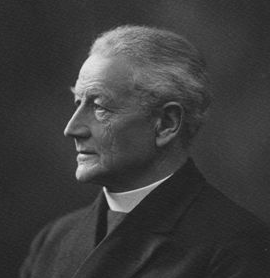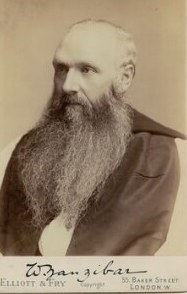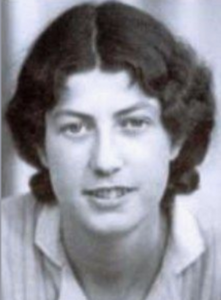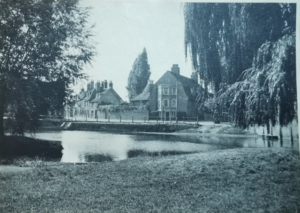Search by topic
- archaeology
- Building of Local Interest
- chapel
- charity
- church
- crime
- dressmaker
- fire
- Great Eastern Railway
- Listed building
- Mapping Relief
- medieval
- oral history
- poverty
- Public House
- Religious House
- Roman
- scholar
- school
- Then and Now
- tudor
- women
- work
- world war one
- world war two
Search by text
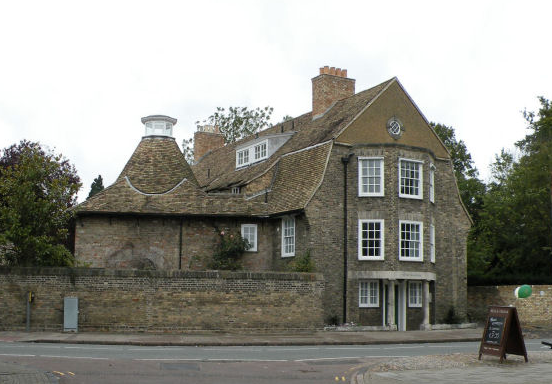 Malting House, Malting Lane
Malting House, Malting LaneLittle Newnham, Frostlake Cottage and the Malting House, Malting Lane (Malting House School)
History of the Little Newnham
Royal Commission Survey of Cambridge 1959: Little Newnham and Frostlake Cottage … it occupies the W end of a range of buildings along the S side of malting Lane of 18th cent. origin but very much altered, comprising houses, cottages, maltings, last-houses and stables; malting House at the E end has been so extensively remodelled that it is virtually a modern building. The house was built early in the 19th century, enlarged later in the first half of the same century, and subsequently divided into two tenements: Little Newnham to the W., Frostlake Cottage to the E., the latter incorporating a lower range of early 18th century buildings on the E., probably originally stables, for the kitchen, etc.
Information about the school that was run at this site can be found here:
https://en.wikipedia.org/wiki/Malting_House_School
The Malthouse, at the Newnham Road end of the lane, was only in operation for around 30 years, one of 12 breweries in Cambridge which vanished in a relatively short space of time. It is listed in Spalding’s street directory for 1884 and 1887 as Foster Brothers’ Malting, and for 1895 as Robinson and Tebbutt’s Maltings. The Malthouse was then converted into a granary, before being extensively reconstructed by the architects Smith & Brewer in 1909 as an “arts and crafts” house: “a long, mansard-roofed range entered by a classical porch at the short end”.32 The reconstruction was made necessary by the widening of Newnham Road, previously a narrow track, to increase its traffic flow. Before that, Malting Lane had been a main route into Cambridge, and – as indicated in the 1886 map – both the Lane and the Malthouse extended closer to Newnham Mill.
From No 3 Summerfield, Cambridge – A House, Street and Area History
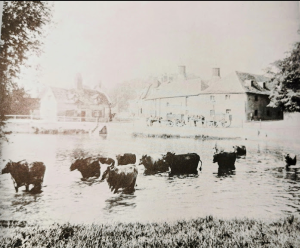
Newnham Mill Pool,c1900. Jolly Millers, left, brewery late The Malting House on right. Mott’s cows are fording the river.
1903
The CWN article about Newnham in March 1981 noted that the Stewart family had visiting books that go back to 1903 showing a stream of European intellectuals who visited the house. The German violinist came to plant a tree in the garden. Before the playroom was turned into an assembly room in 1912 and thereafter used by the Quakers, who licensed it for weddings, by Morris dancers, and later the School Holiday Orchestra, it was lent to the Archaeological Museum to store mummies in.
Albert Schweitzer lectured there, composers Alban Berg, Kodaly (several times), Vaughan Williams signed the book. T.S.Eliot came and “Granny Stewart” drove him over to Little Gidding.
The Malthouse was sold as The Malting House to the Rev. Hugh Fraser Stewart, Chaplain at Trinity and later Fellow, Dean and Lecturer (in Modern Languages) at St John’s, who is first listed in Spalding’s for 1907. As President of the Cambridge University Musical Society, he provided hospitality to various famous composers who came to conduct their works. Under the Stewart family, The Malting House became known for its patronage of the arts in general, and music in particular. In 1918, its playroom was converted34 into a recital/concert hall where much of the University’s musical life took place. The Stewart family had visiting books that went back to 1903, showing a stream of European intellectuals who visited the house. Albert Schweitzer lectured there, and composers Alban Berg, Kodaly (several times) and Vaughan Williams signed the book. T.S. Eliot came and Hugh Stewart’s wife drove him over to Little Gidding, around 30 miles from Cambridge, which was subsequently the title of the last of his Four Quartets. Jessie Stewart was one of the earliest women undergraduates at Newnham College, a classical scholar and a student and later biographer of Jane Harrison, who is regarded as one of the founders of modern studies in Ancient Greek religion and mythology. (See No.3 Summerfield, above)
1912
In May the remains of the malting, formerly used to store grain, were converted into a small hall with two galleries and a stage. Many concerts and meetings were held there, including a lecture by Albert Schweitzer. (Vanishing Cambridge, Mike Petty p.35)
1913
(The Malting House) Rev Hugh Fraser Stewart
H L Pass, St John’s College
Rt Rev Bishop William Moore Richardson (late of Zanzibar)
Rev T Thompson, Caius College
Rev J F Buxton, Clare College
Hugh Fraser Stewart’s daughter was Frida.
For more information see:
A Cambridge hero who took on the fascists – in two conflicts…and lived
Book Review: The Memoirs of Frida Stewart, published 01 July 2020.
Frida Knight leads 2,000 anti-nuclear weapons protestors through Cambridge. 1980
Early 1930s: home to the philosopher Ludwig Wittgenstein.
1962
(The Malting House) Mrs J Stewart, L D Stewart
(Malting Cottage) Miss A Nunn
(The Loft) George D S Henderson
(Frostlake Cottage) Meyrick C M Owen
(Little Newnham) Patrice E Charvet
(Church Rate Corner) Henry S Bennett
Church Rate Corner is a listed building, built 1924.
1970
The Loft, Malting House: J Pace
Frostlake Cottage: C M Owen Meyrick
Little Newnham: David Maull
Church Rate Corner: Henry S Bennett
Contribute
Do you have any information about the people or places in this article? If so, then please let us know using the Contact page or by emailing capturingcambridge@
License
This work is licensed under CC BY-NC-SA 4.0





